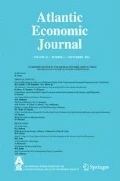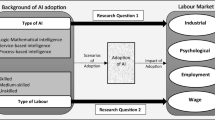Abstract
This paper examines the effects of labor-replacing capital, referred to as robots, on business cycle dynamics using a New Keynesian model with a role for both traditional and robot capital. This study finds that shocks to the price of robots have effects on wages, output, and employment that are distinct from shocks to the price of traditional capital. Further, the inclusion of robots alters the response of employment and labor’s share to total factor productivity and monetary policy shocks. The presence of robots also weakens the correlation between human labor and output and the correlation between human labor and labor’s share. The paper finds that monetary policymakers would need to place a greater emphasis on output stabilization if their objective is to minimize a weighted average of output and inflation volatility. Moreover, if policymakers have an employment stabilization objective apart from their output stabilization objective, they would have to further focus on output stabilization due to the deterioration of the output-employment correlation.







Similar content being viewed by others
Notes
This implies that the difference between capital and robots in this specification is the difference in their depreciation rates.
In other words, when traditional capital and composite labor are complements and when robots and human labor are substitutes.
While this paper includes the correlations in the data, the purpose of this paper is not to match empirical moments, but to explore the effects of robots in a business cycle model.
References
Ambler, S., & Cardia, E. (1998). The cyclical behaviour of wages and profits under imperfect competition. The Canadian Journal of Economics, 31(1), 148–164.
Blanchard, O., & Galí, J. (2007). Real wage rigidities and the New Keynesian model. Journal of Money, Credit and Banking, 39, 35–65.
Brynjolfsson, E., & McAfee, A. (2014). The second machine age: work, progress, and prosperity in a time of brilliant technologies. New York: W. W. Norton.
Calvo, G.A. (1983). Staggered prices in a utility-maximizing framework. Journal of Monetary Economics, 12(3), 383–398.
Chirinko, R.S. (2008). σ: The long and short of it. Journal of Macroeconomics, 30(2), 671–686.
Choi, S., & Ríos-Rull, J.V. (2009). Understanding the dynamics of labor share: the role of noncompetitive factor prices. Annals of Economics and Statistics (95/96), 251–277.
Gomme, P., & Greenwood, J. (1995). On the cyclical allocation of risk. Journal of Economic Dynamics and Control, 19(1), 91–124.
Hansen, G.D., & Prescott, E.C. (2005). Capacity constraints, asymmetries, and the business cycle. Review of Economic Dynamics, 8(4), 850–865.
Justiniano, A., Primiceri, G.E., Tambalotti, A. (2010). Investment shocks and business cycles. Journal of Monetary Economics, 57(2), 132–145.
Krugman, P. (2012). Rise of the robots. http://krugman.blogs.nytimes.com/2012/12/08/rise-of-the-robots/. Accessed 8 Dec 2012.
Krusell, P., Ohanian, L.E., Ríos-Rull, J.V., Violante, G.L. (2000). Capital-skill complementarity and inequality: a macroeconomic analysis. Econometrica, 68(5), 1029–1053.
Kydland, F.E. (1995). Business cycles and aggregate labor market fluctuations. In Cooley, T.F. (Ed.) Frontiers of Business Cycle Research (pp. 126–156). Princeton University Press, chap 5.
Smets, F., & Wouters, R. (2005). Comparing shocks and frictions in U.S. and Euro Area business cycles: A Bayesian DSGE approach. Journal of Applied Econometrics, 20(2), 161–183.
Summers, L.H. (2013). Economic possibilities for our children. In: The 2013 Martin Feldstein Lecture, National Bureau of Economic Research, no. 4 in NBER Reporters OnLine, http://www.nber.org/reporter/2013number4/2013no4.pdf. The 2013 Martin Feldstein Lecture.
U.S. Bureau of Economic Analysis. (2019). Real gross domestic product [GDPC1]. https://fred.stlouisfed.org/series/GDPC1, retrieved from FRED, Federal Reserve Bank of St. Louis on February 1, 2019.
U.S. Bureau of Labor Statistics. (2019a). Nonfarm business sector: Hours of all persons [HOANBS]. https://fred.stlouisfed.org/series/{HOANBS}, retrieved from FRED, Federal Reserve Bank of St Louis on February 1, 2019.
U.S. Bureau of Labor Statistics. (2019b). Nonfarm business sector: Labor share [PRS85006173]. https://fred.stlouisfed.org/series/{PRS}85006173, retrieved from FRED, Federal Reserve Bank of St Louis on February 1, 2019.
Author information
Authors and Affiliations
Corresponding author
Additional information
Publisher’s Note
Springer Nature remains neutral with regard to jurisdictional claims in published maps and institutional affiliations.
The authors thank the participants of the 2014 Liberal Arts Macroeconomic Workshop, especially Bill Craighead, the discussant of the paper; the 2014 Canadian Economic Association Annual Conference; and seminar participants at the National Taipei University in 2015 for their invaluable comments and suggestions.
Electronic supplementary material
Below is the link to the electronic supplementary material.
Rights and permissions
About this article
Cite this article
Lin, Tt.T., Weise, C.L. A New Keynesian Model with Robots: Implications for Business Cycles and Monetary Policy. Atl Econ J 47, 81–101 (2019). https://doi.org/10.1007/s11293-019-09613-w
Published:
Issue Date:
DOI: https://doi.org/10.1007/s11293-019-09613-w




